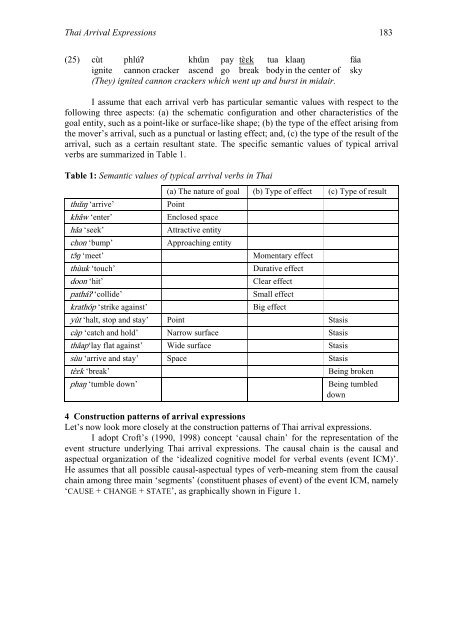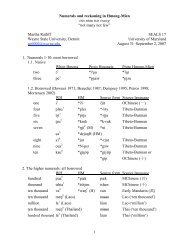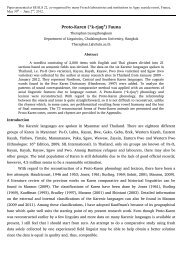proto-southwestern-tai revised: a new reconstruction - seals 22
proto-southwestern-tai revised: a new reconstruction - seals 22
proto-southwestern-tai revised: a new reconstruction - seals 22
You also want an ePaper? Increase the reach of your titles
YUMPU automatically turns print PDFs into web optimized ePapers that Google loves.
Thai Arrival Expressions 183<br />
(25) cùt phlúɁ khɯ̂ n pay tɛ̀ɛk tua klaaŋ fáa<br />
ignite cannon cracker ascend go break body in the center of sky<br />
(They) ignited cannon crackers which went up and burst in midair.<br />
I assume that each arrival verb has particular semantic values with respect to the<br />
following three aspects: (a) the schematic configuration and other characteristics of the<br />
goal entity, such as a point-like or surface-like shape; (b) the type of the effect arising from<br />
the mover’s arrival, such as a punctual or lasting effect; and, (c) the type of the result of the<br />
arrival, such as a cer<strong>tai</strong>n resultant state. The specific semantic values of typical arrival<br />
verbs are summarized in Table 1.<br />
Table 1: Semantic values of typical arrival verbs in Thai<br />
thɯ̌ ŋ ‘arrive’ Point<br />
khâw ‘enter’ Enclosed space<br />
hǎa ‘seek’ Attractive entity<br />
chon ‘bump’ Approaching entity<br />
(a) The nature of goal (b) Type of effect (c) Type of result<br />
tɔ̂ŋ ‘meet’ Momentary effect<br />
thùuk ‘touch’ Durative effect<br />
doon ‘hit’ Clear effect<br />
patháɁ ‘collide’ Small effect<br />
krathóp ‘strike against’ Big effect<br />
yùt ‘halt, stop and stay’ Point Stasis<br />
càp ‘catch and hold’ Narrow surface Stasis<br />
thâap‘lay flat against’ Wide surface Stasis<br />
sùu ‘arrive and stay’ Space Stasis<br />
tɛ̀ɛk ‘break’ Being broken<br />
phaŋ ‘tumble down’ Being tumbled<br />
down<br />
4 Construction patterns of arrival expressions<br />
Let’s now look more closely at the construction patterns of Thai arrival expressions.<br />
I adopt Croft’s (1990, 1998) concept ‘causal chain’ for the representation of the<br />
event structure underlying Thai arrival expressions. The causal chain is the causal and<br />
aspectual organization of the ‘idealized cognitive model for verbal events (event ICM)’.<br />
He assumes that all possible causal-aspectual types of verb-meaning stem from the causal<br />
chain among three main ‘segments’ (constituent phases of event) of the event ICM, namely<br />
‘CAUSE + CHANGE + STATE’, as graphically shown in Figure 1.





